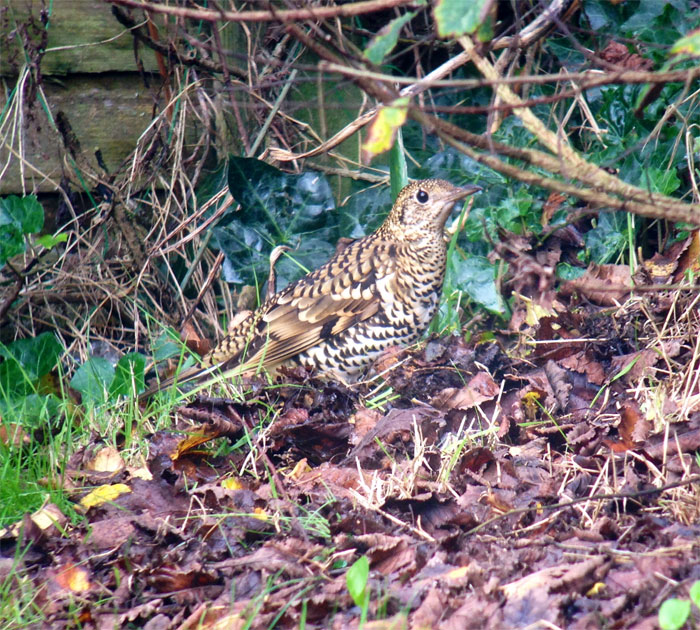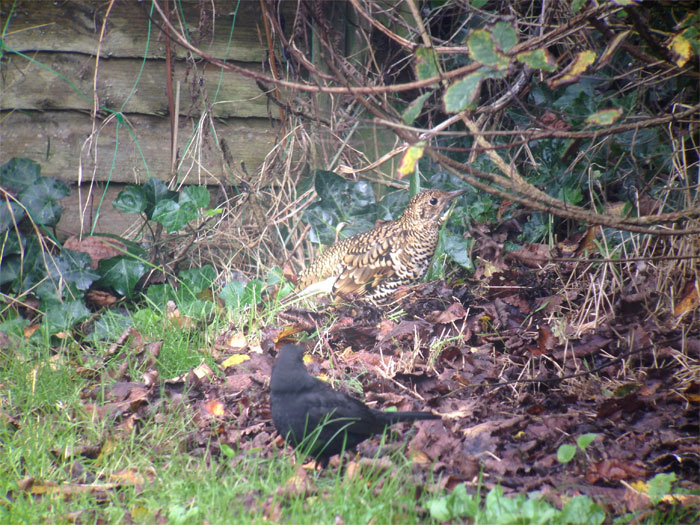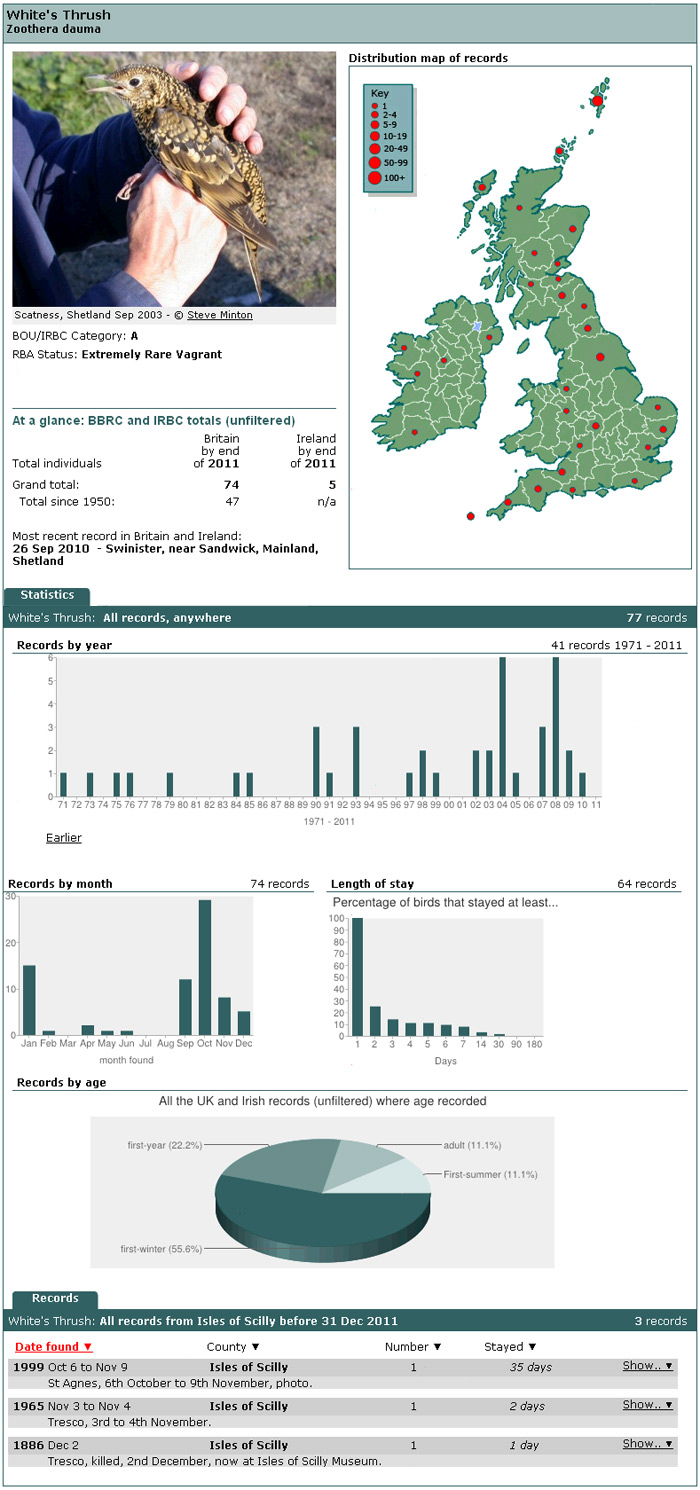Finders report: White's Thrush St.Agnes Isles of Scilly Oct 2013
Steve Williams

"As a child my mum and dad (who got me into birding) took us to the North Norfolk coast each October half term - how spoilt we were, seeing migrants arriving off the North Sea onto the shingle embankments and scrub. Woodcocks were my favourites but seeing my first Pallas's Warbler at Holme and then another the same day at Cley beach in October 1988 will live long in my memory. However, I always dreamed of finding my own birds...
Now all grown up (well older anyway), my own family and I have spent an extended October half term week (traditionally referred to as 'teacher's week' during Scilly Season) on my favourite Scilly island, St Agnes, for the last five years.
My long suffering wife, Clare, and now four children love St Agnes where we thoroughly enjoy the stunning scenery, lovely (though variable) weather, great beaches, wonderful food and the superb hospitality of the islanders.
The birding had been enjoyable during our first week, although there were rumblings by some of it being quiet; I was happy with finding an RBF on my first evening, a couple of Yellow-browed Warblers, the long-staying Short-toed Lark and a rather late Turtle Dove (after all that haul would be an amazing year on my patch - my other favourite island Hilbre).
We always try to stay in Glebe Barn at the Parsonage because it is central for the family, the accommodation is lovely, the owners (Pam and Julian) have always been very good to us with our increasing brood and, of course for me, it is one of the best places on the island for birding.
A slight change in the wind direction to south east overnight meant that on Friday 25th there had been a noticeable arrival of birds including an increase in Chiffchaffs and Redwings. Just after seeing off our good friend Barry Barnacal (who had been staying in the Parsonage for four weeks - sorry Barry) I had a very brief glimpse of a small phyllosc which I was convinced had a crown stripe and spent two hours under the canopy of the trees of the parsonage trying to nail it - half way through a Yellow-browed appeared and the doubts crept in - but I persevered and the Pallas's Warbler re-appeared. I was absolutely delighted with my find - I'd ignored news of two new RBFs to nail it and it had paid off. Although I wasn't popular with the family as I'd promised them a walk on Wingletang which never materialised.
I enjoyed the rest of the day thoroughly; including twitching one of the RBFs in Covean. On days like this, which are few and far between for me, I always try and stay in the field as long as possible as I had that great birding feeling of finding a good bird (that I'm not convinced Clare quite understands).
So it was at approximately 550pm that I was meandering through the bottom of the Parsonage garden for the last ten minutes of the day occasionally flushing a Collared Dove and hoping to re-find the Turtle Dove so I could grill it when heading back to the barn I moved towards the apple trees. Suddenly from just a few yards left of my feet exploded 'a large thrush-like bird with black scaly upperparts and distinctive white tail corners' which flew across my path and dived into the dark bottom corner or perhaps through the hole in the hedge. It was a split second or two and quite frankly I literally couldn't believe my own eyes.
I racked my brains as to what else (other than the obvious but surely ridiculous) it could have been - and I came up with nothing. I put the description in quotes above because this is what I told most people I met in the fading light that evening and a couple of people on the phone.
I was literally stunned - I'm not sure I've ever been as stunned before whilst birding. I remember finding Grey-cheeked Thrush with my brother, Chris, on St Agnes in 1991 and I wasn't shocked at all. Delighted yes, but not shocked, but then that diminutive thrush gave us a prolonged view and I remember garbling something to him about checking the head pattern, eye-ring, tail colour etc (as it was September and the earliest Grey-cheeked ever in Britain).
This was different - I panicked - it had gone, a split second view of a mega. I popped my head in the barn and in a state of shock said to Clare that I wouldn't be back for dinner after all - I got short shrift.

I meandered about for a minute or so doing my best impression of a headless chicken wondering what to do next.
I headed for the road as I'd spotted another birder, Trevor, who was staying on the island. I told him what I'd seen (see quote!) - he looked either shocked or disbelieving I couldn't work out which, but he was quick to offer to help look in the fields below the Parsonage to which he had access from the owner Francis Hicks.
We headed down and crept along the best looking hedgerows meeting another birder or two on the way. I can't quite remember because I was definitely in shock ... there was no sign of 'the bird'. Doubts crept in - did I see what I thought I saw, what else could it be?
We bumped into Francis in his vehicle and being a birder he stopped and asked what we were obviously looking for ... I told him what I'd seen. "Well that's a White's Thrush!" he stated sounding very straightforward. "Yes" I mumbled in response probably shaking my head ... I thought at this point that things had possibly got out of my control. I would love to now say that I had no doubts it was clearly a White's Thrush...but that is not true. I doubted myself, not for the first time, or the last, I doubted my own eyes. But try as I might, I could not think of anything else that fitted - but was it as scaly as I'd thought, where the white tail corners as obvious or was the evening light playing havoc with my eyes...
I recall the story of Ren Hathaway finding the 1999 White's Thrush on St Agnes and needing to sit down and have a cup of tea ... I now understand that feeling entirely, although I chose the less poetic option...I went to the Turk's Head that night with Chris, partly to celebrate the Pallas's and partly to try and help me get some sleep as I knew I would have a restless night.
Chris and I were staying on the island at the same time for the first time since that trip in 1991. My brother was very supportive and didn't doubt me for an instant - perhaps he knows me better than I do myself.
That night was restless despite the Turk's Ale medicine (tea would've been the better option after all) ... but I was up and out very early. I crept along the same path at the bottom of the Parsonage - nothing but Song Thrushes and Collared Doves. I suppose I was hoping it would be sat on the lawn...little did I know what would follow.
Disappointed I poked my head through the hole and spotted David Bradshaw and Marek Walford who were observing from the fields below. David raised his thumbs in a positive gesture. Was he asking me whether I'd seen it again? I put my thumb down and then up in a questioning manner ... he put both thumbs up again and they headed over to me, I panicked thinking he'd misread my gesture. Remarkably, however, they explained that they had both seen the bird fly out and it had banked and revealed the underwings - definitely a White's Thrush. For the second time in less than 24 hrs I was shocked - I could've hugged them both (but I don't know them that well!) I was relieved and elated at the same time.
Now three of us had seen it and they had crucially seen the underwing pattern...no doubts now and despite the bird not showing again during the morning the three of us were now happy with what we'd seen.
Heavy rain late afternoon on the Saturday seemed to have put pay to casual talk of a good search for the bird that evening. However, several birders who had permission appeared in the fields below at around 530pm with the rain having abated and a few from the Seabird Recovery Project, who were staying at the Parsonage, positioned themselves at the corner.
At this point I volunteered to walk the path along the bottom again. I phoned Chris and told him I was starting the walk at the far corner and before I got any further I got a return call from him explaining that the White's Thrush had flown out past the birders in the field and then flown back over the barn right past the birders in the parsonage. I walked a bit further and heard a cheer from the small assembled group in the field below; the bird had apparently banked and shown off its underwing to everyone except me - I hadn't seen it at all.
Then Chris phoned back, someone had relocated it in a field. I ran into the barn grabbed my eldest son Thomas and my scope and we ran around to find the others staring into the field and watching the White's Thrush bobbing on the grass in the, by now, fading light ... everyone was delighted. A few Agnes regulars hadn't come out to join the search that night but by the time I left the island on 30th they had all seen it as had some more from St Mary's and elsewhere.
There was lots of back slapping, a few hugs and a great night in the Turk's Head that night.
I have to say everyone was very kind and I had lots of messages of congratulations from on and off St Agnes but one will stick in my memory - Paul Dukes, of much St Agnes fame, including finding Wood Thrush and Semipalmated Plover on the island, generously asked me where on the island I was heading next so he could follow me! If I'd been more quick-witted I may have said the Turk's but I just giggled like a school boy being congratulated by a teacher.
After the excitement and stalking of Friday evening and Saturday the bird settled down into the bottom corner of the Parsonage where I found it several times on the Sunday including being able to scope it in the open (getting some video and photos with my iPhone in the rain).
However, this made it quite difficult as there is no general access to the Parsonage. But over the next few days it became more accustomed to movement and people and after I left the island it could apparently be seen from the road on the lawn.
Without making this sound like an oscar speech I would really like to thank David Bradshaw and Marek Walford for re-finding the bird in the morning, helping nail it and putting me out of my misery.
Some people think it was the same bird as had been seen on 30th September and 1st October ... but this was over three weeks earlier. Also I prefer the opinion of Doug Page, who lives on St Agnes, who pointed out that the same day I flushed the White's Thrush a Pallas's (joined by a second the next day were all in the same garden and from similar global ranges) and 2 RBFs had been found, a Radde's was reported next day and soon after a Dusky and a Paddyfield were all found on St Agnes - quite a purple patch for the island. I guess we'll never know for sure.
However, finding a Pallas's Warbler and a White's Thrush on the same day were what I dreamed of as my dad, sadly no longer with us, walked me and my brother along the North Norfolk coast as children each October half term. I will never forget October 2013 half term on St Agnes."
Steve Williams - Oct 2013





